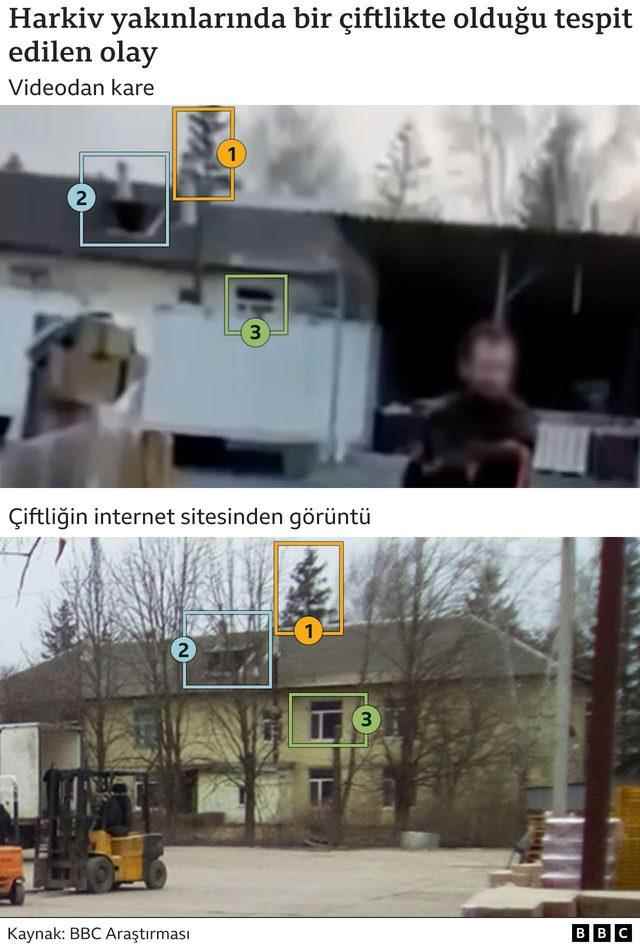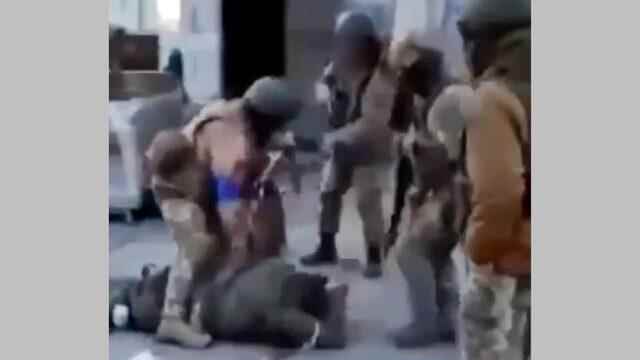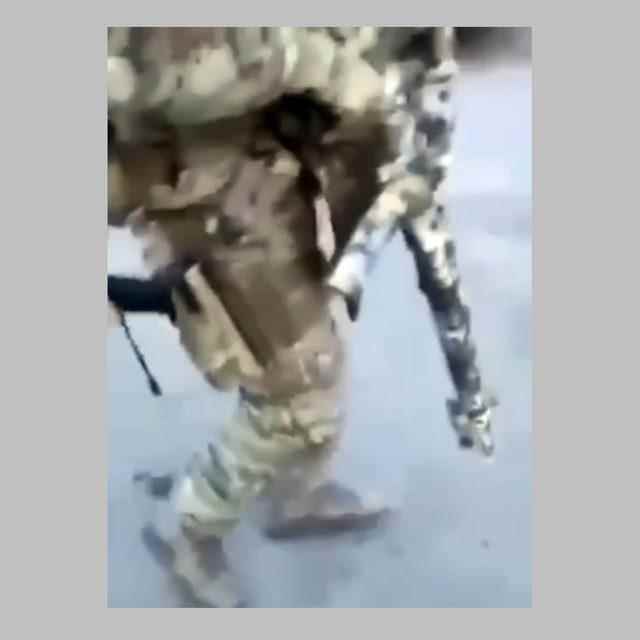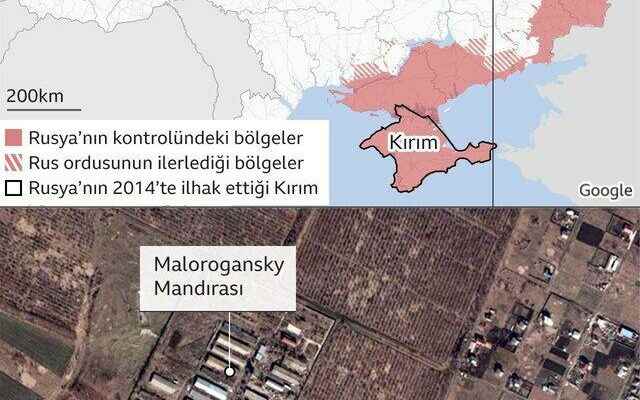Ukrainian authorities are investigating video footage allegedly showing Ukrainian soldiers shooting Russian prisoners of war in the legs. BBC Reality Check and BBC Watch Services reviewed this video.
The blurry video circulated on social media after it first appeared in the early morning hours of Sunday, March 27. It has since been shared and popularized by accounts supporting Russia.
Valeri Zaluzhnyi, Commander-in-Chief of the Ukrainian Armed Forces, said Russia was “making and distributing fake videos” to discredit Ukraine’s treatment of Russian prisoners.
However, Oleksiy Arerestovic, Advisor to Ukrainian President Volodymyr Zelenskiy, said that an investigation would be launched immediately and said, “I would like to remind all our soldiers, civilians and defense forces that harassing prisoners of war is a war crime.”
The BBC is reviewing this video and has yet to independently verify it. As we continue to review the footage, we share what we’ve learned so far:
What is shown in the video?
The video, too disturbing to be published in its entirety, shows a series of captive soldiers lying on the ground. Some have bags on their heads, and many seem to bleed from wounds on their legs. It is unclear how and when they were injured.
Prisoners are questioned by their detainees and asked about their units and activities in the area.
At one point, the three men are ejected from a vehicle and appear to have been shot in the legs by a soldier.
These men are being questioned after being shot.
Where was the video shot?
On Sunday evening, a Twitter user claimed that the video was shot at a dairy in Malaya Rohan, southeast of Kharkiv. The BBC used geolocation tools to verify the location. The area had recently been retaken from Russian forces by Ukrainian troops.
By analyzing satellite images and pictures of the farm, we can identify clues about the location of the video.
Before the three soldiers were shot, we could recognize the elements of the house behind one. The tree (1) behind a white structure, a chimney (2), and the top half of a window (3) look very similar to previous images of the dairy surroundings we found on the farm’s Google webpage.

There are instantly more visual clues as the video appears in the foreground with the soldiers lying on the ground.
The white structure (4) and chimneys (1), the trees and the black wall (2) are located in the main open area of the farm.
The BBC contacted this dairy.
When was it taken?
The video footage has no time or date stamp and no metadata that would allow us to identify exactly when it was taken.
But according to snapshots of the sky, the weather is clear and the ground is dry.
Weather reports from the Kharkiv region indicate that the video may have been shot on Saturday, March 26. The weather on Friday and Saturday was dry, sunny, but cold. Light rain was recorded in the area during the night connecting Saturday to Sunday.
The position of the sun in some video frames suggests that the images may have been taken earlier in the day.
What is being said?
Prisoners are questioned in Russian. A linguist from the BBC Monitoring Service said that the accents of the questioners were “in line with what is expected of Russian-speaking Ukrainians”.
Another expert confirmed that the soldiers spoke with the Ukrainian eastern accent, pointing to the use of “hovorit” (“speak”) instead of Russian “govorit”.
At one point, one of the prisoners is accused of bombing Kharkiv, another is asked about his nationality, and the soldier says he is Azerbaijani.
One of the captives says he served in Biskvitne, close to the Malaya village of Rohan and the dairy we identified.
Who are the soldiers?
The accents of military prisoners are consistent with what is spoken in eastern Ukraine. However, this does not confirm that they were Ukrainian soldiers. Because it is possible that they are pro-Russian separatists from this region.
They also wear uniforms with blue armbands used by Ukrainian forces, but this does not provide sufficient evidence for us to draw conclusions immediately.

The absence of regimental badges or other identification makes them very difficult to identify.
But we do know that Ukrainian forces are nearby.
During the weekend of March 26-27, a video showing the activities of the Kraken unit affiliated with the far-right National Corps political group was posted online. The BBC found that this video was shot in the village of Vilkhivka, 5.6 km from Malaya Rohan, by geolocation analysis. The weather was also sunny and dry.
The group said that on March 25, 30 Russians were taken prisoner in the village. In the Kraken video, captive and blindfolded prisoners of war are put in a van and at one point forced to sing the Ukrainian national anthem. However, there was no shooting or any serious act of violence.

In the video of the alleged shooting of soldiers at the dairy, one of the soldiers is seen crossing with his rifle, which can be distinguished by its camouflage.
We asked Nick Reynolds, a military expert at the Royal United Services Institute (RUSI), a UK defense and security think tank, to review this part of the image.
Reynolds “Ukrainian SOF [özel kuvvetlerin] “It looks like the camouflage look of assault rifles, but the gun looks very different from any weapon I’ve ever seen.”
Reynolds also pointed out that both sides had seized weapons from each other and therefore it was difficult to come to a firm conclusion with weapons.
Questions about the shoot
In the most disturbing part of the video, the three men appear to have been shot in the legs with a rifle at close range.
There has been some debate on social media over whether the images are real or fake. Some people said there wasn’t enough blood, there was no evidence of bullet wounds, or that the victims must have been shouting and screaming.
We sought the opinions of trauma surgeons and former military physicians who gave their expert opinions but did not want to be named.
One of these specialists said that he treated bullet-wound soldiers who did not shout and that some of the wounded soldiers did not bleed, which could be explained by the application of a tourniquet. (This is seen in the video).
This expert said: “I am of the opinion that the images cannot be classified as ‘fake’ based solely on what has been seen. This requires a war crimes investigation.”
Another doctor said: “Looks real… What is seen here fits the definition of criminal injuries to the limbs.”
Other comments on social media had claimed that it may have been firing blanks, noting that there was no noticeable recoil when the rifle was fired.
Reynolds notes that the AK-74’s 5.45mm bullet is small in caliber and causes little recoil, but adds that “video quality isn’t great.”
*BBC continues its efforts to verify this video and more evidence emerges*Will update this news if needed.
*Alistair Coleman, Daniele Palumbo, Shayan Sardarizadeh, Richard Irvine-Brown, Vitaly Shevchenko and Paul Myers*with the contributions of
